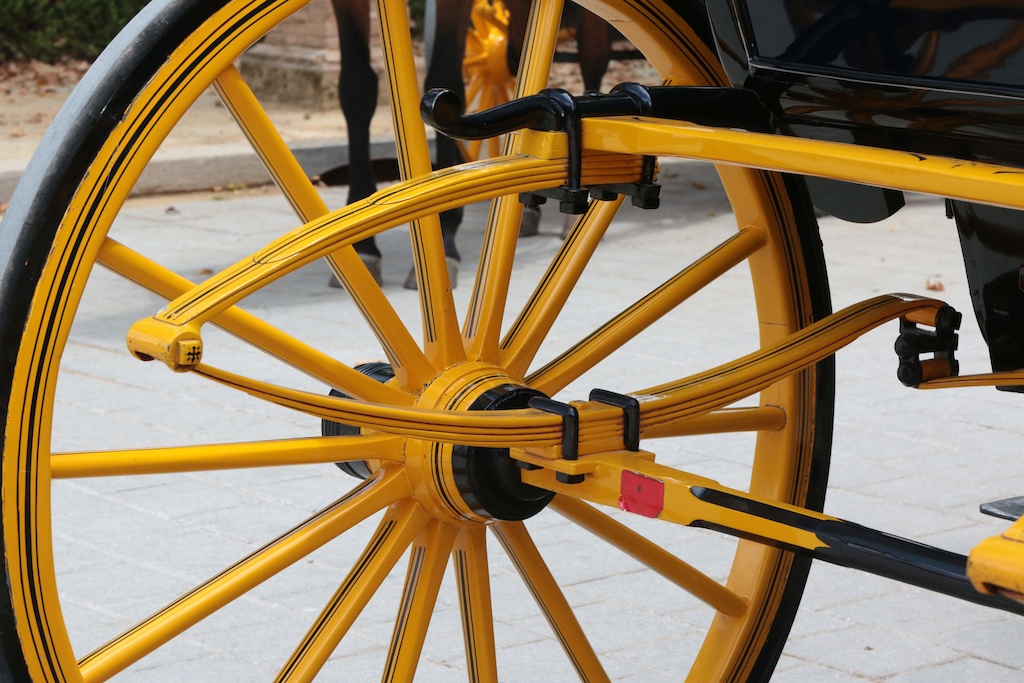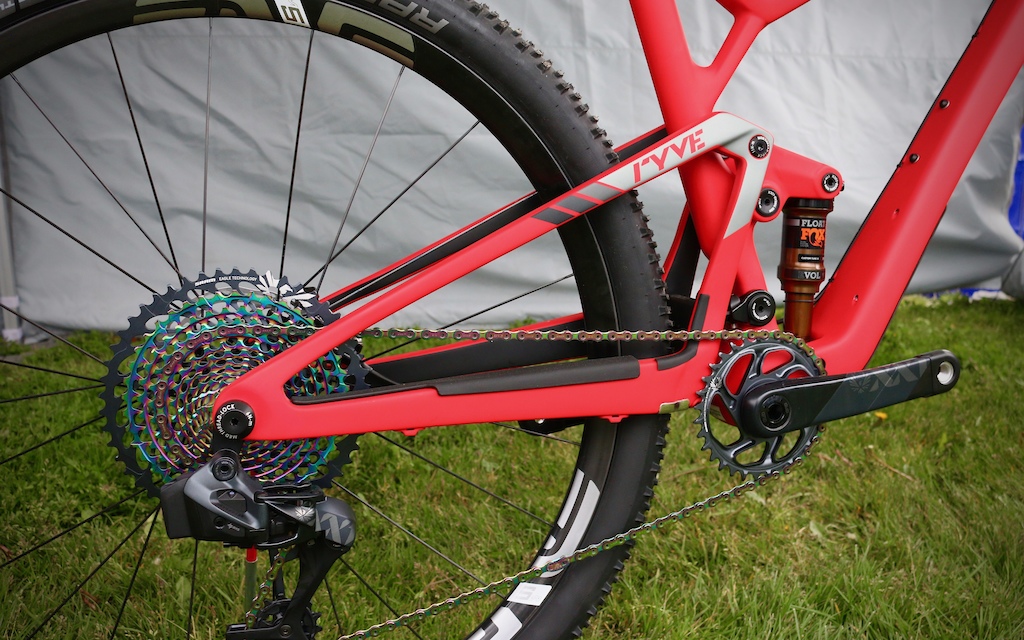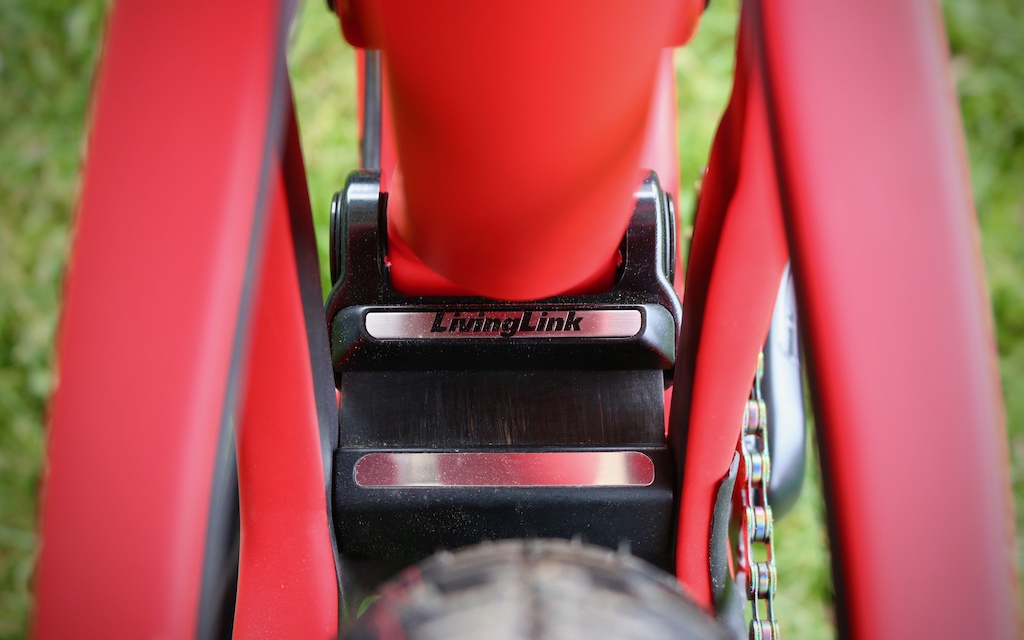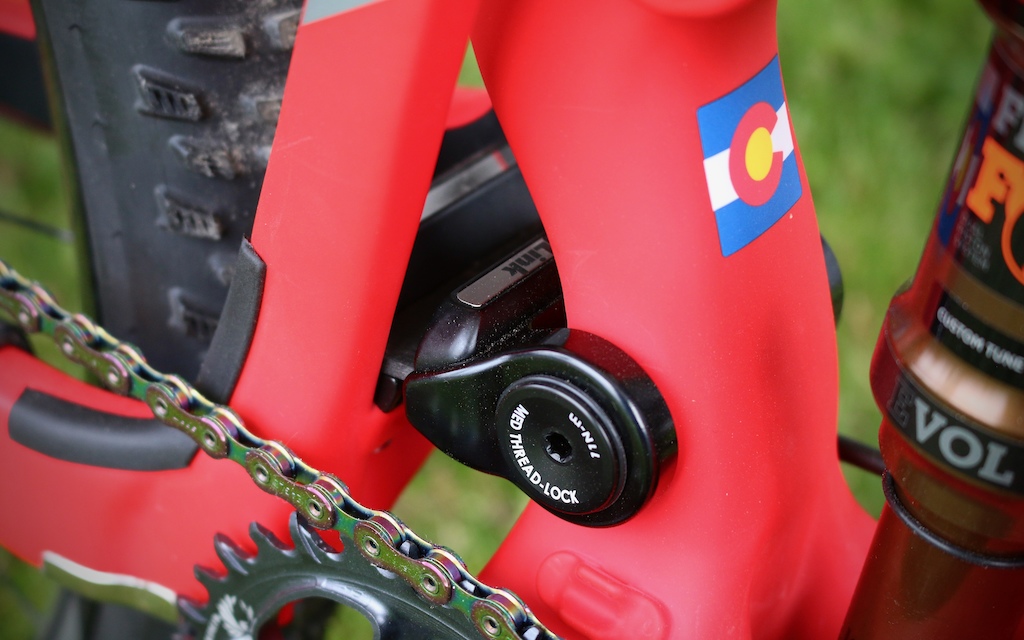Video: Spot's Carbon Leaf Spring - The Explainer
THE EXPLAINER
What's the Deal with Spot's Living Link?
What's the Deal with Spot's Living Link?
Spot's Living Link from left: Main pivot hardware, lower link with bearings on one end and carbon leaf spring on the other, the aluminum pivot hardware that mounts on the chainstay bridge, and the four bolts that attach it all to the swingarm.
Like a lot of things we use today, carbon fiber leaf springs sound sophisticated but are actually based on a design that first showed up a long, long time ago. Back in the mid-1700s, those old English carriageways were rough enough to rattle everyone's (presumably already rotten) teeth loose, but a bit of comfort came in the form of flat steel bars laid on top of one another with the axle put in the middle of it all.
The steel leaf springs both held up the carriage and hopefully took a bit of the edge off those cobbles and potholes when they flexed vertically.
Leaf springs have been around since the mid-1700s and are still in use today.
Jump forward nearly three hundred years and you'll still find steel leaf springs on many modern vehicles, although they're mostly used on heavy-duty trucks or other machines where a simple, reliable suspension solution is needed. You've likely spotted them; flat, heavy pieces of steel that were probably very rusty and primitive looking.
These leaf spring things sound more farm equipment than high-performance, don't they?
The composite leaf springs on both ends of a Corvette (but not the new C8 model) would say otherwise. Their single-element leaf springs are far lighter and many times more reliable than if steel was used, and its shape and packaging mean that they also add an anti-roll element that over-powered cars like the big Vette benefit from.
Furthermore, because different composite parts can be designed to flex more or less while looking essentially the same, the Vette's leaf springs can be made to act precisely how smart people want them to while still fitting the car's tight confines.
There are, of course, plenty of valid reasons why coil springs are more common, but let's see 'em do all that stuff.
Furthermore, because different composite parts can be designed to flex more or less while looking essentially the same, the Vette's leaf springs can be made to act precisely how smart people want them to while still fitting the car's tight confines.
There are, of course, plenty of valid reasons why coil springs are more common, but let's see 'em do all that stuff.
Of course, flexible carbon leaf springs aren't new to the bike world, either, with the crazy-looking Lauf suspension fork probably being the most obvious and current example. But while Lauf's creation uses a bunch of glass-fiber leaf springs to hold the rider up, Spot's Living Link system employs a single, nearly hidden leaf spring that only supplements the bike's Fox shock.
The small section of carbon fiber that makes up half of the lower link is almost completely hidden from view by the Ryve's seat tube and swingarm, but Spot says that it plays a very important role in how the suspension performs.
Spot's new Ryve looks like a normal dual-link bike... Until you take a closer look at the bottom link.
Just like many other dual-link bikes out there, when the Ryve’s rear suspension compresses, both links rotate clockwise; the top link compresses the shock while the bottom link rotates upwards. The carbon leaf spring is completely flat and unloaded at top-out and bottom-out, Spot's Andrew Lumpkin explained to me, meaning that it isn't putting any force into the suspension at those times and the Fox shock is doing all of the work.
But the leaf spring is flexed, or loaded, when the bike is sitting between 25-percent of its travel, otherwise known as the approximate sag point, and 75-percent of full travel. In other words, Spot is using the carbon leaf spring to alter the spring rate in the middle portion of the travel.
Spot says that it wouldn't be possible to have the suspension perform as it does with a normal link in place of the carbon leaf spring.
Why the heck would you want to do that? According to Lumpkin, this lets them create the spring curve they wanted by figuring out their ideal leverage ratios for the beginning and ending parts of the travel. Then they used the carbon leaf spring to tune how the suspension performs in the middle part of its travel where it's loaded and where you spend most of your time.
It's claimed to make the bike very efficient but, more interestingly, they’re also saying that the flexing leaf spring is storing energy that’s returned when the suspension extends. So much so that Spot claims that it can even supply extra “pop” to help you leave the ground. Sounds pretty neat, right? You bet, but I had to reach out to Spot for some clarification on this one.
I mean, does that little carbon leaf spring really store and release energy? And wouldn't the damper just absorb it anyway?
The answers: yes and sort of.
Spot can control how the Living Link flexes by changing the carbon layup (left) to meet their needs. The leaf spring flexes over an aluminum plate (right) that's mounted on top of the chainstay bridge.
First, to understand what's happening, we need to remind ourselves that rebound speed is tied to the spring rate. The firmer the spring, the more that spring wants to extend the shock. Air suspension isn't linear, either, so there will be more rebound force wanting to extend the shock at bottom-out than there is at top-out.
Now let's picture the Ryve's rear-suspension bottomed-out after an impact and starting to rebound.
Because the leaf spring's forces aren't being applied to the suspension from bottom-out to 25-percent extension, the rebound speed will be relatively slow until the leaf spring begins to enter the equation. From that point to 75-percent extension, the leaf spring is flexing and working in conjunction with the shock's air spring. Then, when the suspension extends past that point, the leaf spring goes straight and no longer applies any force, which means a slower relative rebound speed near top-out than if the carbon was replaced with a normal, non-flexy link.
What all that means is slower, presumably more controlled rebound after big impacts that use most of the bike's travel, faster rebound after small and medium impacts in the middle portion of the bike's travel, and then slower rebound (relative to if the link didn't flex) at the top of the travel.
What all that means is slower, presumably more controlled rebound after big impacts that use most of the bike's travel, faster rebound after small and medium impacts in the middle portion of the bike's travel, and then slower rebound (relative to if the link didn't flex) at the top of the travel.
The benefits to all that, Lumpkin told me, is that they can ''preserve the big hit recovery near bottom out, but also preserve the traction benefits of slower rebound near top out.''
So, do you think there's something to Spot's carbon leaf spring, or is it just different to be different? I've got a 115mm-travel Ryve in for testing, so stay tuned for a video review and a verdict on the Living Link system.
Author Info:
Must Read This Week
Sign Up for the Pinkbike Newsletter - All the Biggest, Most Interesting Stories in your Inbox
PB Newsletter Signup











 Member since Oct 18, 2005
Member since Oct 18, 2005
Mike Leafy you mean
It was on after a pinkbike video of man crashes from broken frame on whole enchilada. I was just recently there at the time so watched it for the crash.
It pumps extremely well and has an incredibly lively feel to it as well.
I used the lockout for the first time about two weeks ago, for a 6 mile (one way) road transfer. Forgot to turn it on until halfway through.
I'd agree with the others, power transfer over uphill tech isn't as thoughtless as with a Horst or DW-link.
So it kinda seems to me that this is just an opportunity for the marketing department, really. Spot's only eliminating two bearings - the link still requires bearings. Doubt this is really a fundamental improvement over rigid dual-link designs.
Huh. I guess you know best.
"I'm just a non-engineer internet nobody ..."
Yet you chimed in on suspension engineering anyway. Well done.
Without seeing their testing there really isn't a way to determine the durability of the system, but i doubt it is by any significant amount more prone to failure than a standard solid link. Assuming it was properly designed and tested.
^this the only fella here who knows what he's talking about
@Spot-Engineering (Feb 9, 2018 at 12:43)
@ VTwintips: What counts as a cycle is a full flexion of the leaf spring. This happens at ~50% travel, whether headed for bottom out or top out. So any bump, jump, drop etc. that pushes the suspension past 50% will effectively result in two cycles. I'm not sure how one might expect to factor crank revolutions into this. When pedaling on smooth trail, the bike stays in the sag range, and doesn't activate the suspension to anywhere near 50% travel.
During the development of this system, we fitted one of our test mules with a data acquisition system that measured suspension cycles. Our typical daily lunch ride is the Apex trail here in Golden (for curious locals, our route for this test is up Pick 'n Sledge, up upper Apex, down Enchanted forest and down "The Gut"). This ride takes most riders 1.5-2.5 hours, depending on fitness, and as we ride it from our HQ, it covers about 10 miles and 2000 vertical feet, and it isn't smooth! One lap of this ride yields ~675 cycles of the leaf spring as measured by our equipment (it's really distracting to watch the cycle count display while riding BTW).
We've tested the leaf spring to 3 million cycles with no failure. In that time I replaced most of the bearings in the test machine at least once. So if you ride our Apex lap EVERY DAY, our testing shows that you can go about that for over 12 years. At that point you'd have replaced every moving part on the bike multiple times, but the leaf spring would still be going strong.
Hopefully this clears up any concerns of longevity.
Spring has no damping by itself.
Leaf is not workin on first and last 25% of travel so without any other spring rear triangle would just spin around pivots without any damping. So the chart would start at 25% of travel and end at 75% with no force in the left percentages.
So you will have a sligtly better spring curve as their graph shows, with less air in your shock. whatever is your weight or size.
And that's it. They added many words in the article to use space and sound clever.
For example if an average person (lets say 160lsb) required 100PSI in the shock and it adds an additional/in they will feel a certain benefit. Then my large ass gets on the same bike and I weigh 260lbs. The leaf spring will add the same 10lbs/in and the effect will be marginalized.
My worry is that I would not get the full benefit of the leaf spring.
But As I don't work for them, I can't tell how much of a difference it makes. I'd need numbers.
It looked kinda scary.
And it doesn't really matter. It is their "white" curve that matters. It shows a slightly better overall spring rate. That's the only benefit of this from a "suspension" point of view.
At this time at least, I don't think I've heard anyone else breaking a Spot in a similar manner, so it might have been a user setup issue, who knows.
Additionally, there have been several other Spot frames that broke in the same manner. It's probably why they had to redesign the suspension linkage for their "new" Rollik 150.
Per @stevemokan it wasn't an isolated issue, either...
We actual customers have had an experience like no other. We get invited to group rides, can drop by the office any time to chat and get our bikes looked at, they make cycling kits available to us, priority on demo bike availability, free beer and so much more.
They are a local brand that treats their local customers extremely well. Full open door policy.
...but yeah you just listen to that Youtube influencer and read into crappy comments Iby all) and formulate your opinion...we know how that went down off the internet and I'll stick with my friendly neighborhood bike brand.
"...In our initial analysis, one issue is apparent—the shock was grossly under-pressured and the compression under-damped. It should have had approximately 60psi (33%) more pressure in the shock! Although it had been reported that he hadn’t been bottoming out, many frames in the footage show that the o-ring was off or at least at the end of its travel. Only yesterday were we privy to this additional evidence. It’s up to the rider to notice and remedy such a setup issue. Alex’s intuition was that something was wrong, but he continued to send it.
The purpose of a spring-damper unit is to absorb the energy from the trail or the rider when riding in uneven terrain. If the spring-damper unit is under-inflated and under-damped, it prevents the spring damper unit from absorbing enough of the energy to protect the frame. With this inadequate setup/trail conditions, if you repeatedly deliver a high spike load to the frame, it will likely fail. We hereby explicitly state that if you ride any of our bikes with such inadequate setup, sooner or later expect the same result. Ask any other manufacturer/expert in the field, and they will tell you EXACTLY THE SAME THING. If the frame is not protected from severe bottom-out events, all bets are off—THE FRAME WILL FAIL EVENTUALLY. Have we had a few broken frames since we started selling them two years ago? Of course. Who hasn’t? There’s nothing new here; this is basic physics. There is nothing inferior about our frames.
Then there’s the next factor: the [at least] three crashes on rocky terrain. As we all learned with the famous Minnaar crash last year, crazy things happen in crashes, even to downhill bikes. To define this bike as brand new is misleading due to these crashes and entirely inadequate air pressure and damping setup with the severe riding conditions. Riding aggressive trails aggressively requires suspension adjustments to protect yourself and your equipment. One very important lesson that’s apparent is to always inspect your bike (frame and components) thoroughly, especially when you suspect that something is wrong. This final crash was avoidable. Again, we are extremely grateful that Alex is okay. We will report back when our investigation is complete."
...
"Although our warranty process is known to be extremely forgiving, the whole industry is in a challenging place regarding bikes and their intended uses. Our current models are NOT made to be used for downhill, freeride, slopestyle, park, etc. If they were, they'd be at least 35 lbs. The industry standard that carves out intended use is the ASTM Standard Classification for Bicycle Usage. Unfortunately, the Conditions (classifications) are quite broad. Condition-3 bikes are stated to keep jumps or drops below 24". Condition-4 bikes to keep jumps and drops BELOW 48" and speeds lower than 25mph. Only Condition-5 bikes are for more extreme riding. For anyone out there wanting a bike for extreme riding, the inference is to only purchase a Condition 5 bike."...
It all just felt like a really defensive posture...either way I hope they figured out what went wrong and remedied it. The bikes look great, like the innovation, perhaps some PR learning from that experience was needed but wish them luck.
I now ride a rollik 150 and love it even more than the 607. I can ride any bike I choose, I'm under no contracts. I choose the rollik 150. It's a super fun bike to ride for my style. It won't erase the trail like a big plow bike, but I like that. Spot has been great to deal with, and I wish they were at more demo events so more people could try their bikes.
I do remember them getting really good reviews when released. If they updated the Mayem geo and set it up with a 150 fork, or did a 140/160 I think that would be a cool bike!
Isn't that carbon spring between bottom-out to 25% is fully loaded (so gives a lot rebound force) ?? and starts to be unloaded between 25-75% ? to be fully unloaded in last 25% ? (in first 25% and fully extended state)
If you just do the shock your missing like half the picture.
And if you do virtual forces your missing all the variables from links, rear triangle, pivot bearings, etc.
So, in summary - all you mfgs graphs are useless (mostly)
Yes its possible to do lots of revolutionary stuff if there are no constraints from technical rulebook, but usually this stuff will be just proof-of-concept type of engineering with some massive compromises in usability/serviceability/cost/etc.etc. What rulebooks produce is simple, but highly refined design. And I like refined stuff.. Unfortunately, in bike industry not many companies want to invest in refining things , its more marketable to do something new and unorthodox, than just simply do a good product.
I don't get what you arguing for. F1 uses a spring and damper at each wheel, an anti-roll spring, sometimes an anti-roll damper, often when they figure out a loophole (or hide it real good), some sort of mass damper or inertial damper, they have massively huge tires that works as springs along with tuned compliance in the suspension. It is far from a spring and a damper per wheel.
Regardless a similar argument could be made that clearly Mountain bikes don't need wheels because rockets don't have them and they work just fine.
Like I previously suggested, look up what the rulebooks are banning. Interconnected suspension in cars would be massively more simple and refined. 3 springs and 4 dampers(which ideally don't do that much) vs what most just regular cars have which is 6 springs and 4 dampers.
In MTB you could use the 1st (main air) spring to set up your ride height/sag, 2nd (living link) spring to make changes to the rate that were independent of the ride height/sag.
An absolutely ideal suspension should have a similar action in any gear or rider input level and then you control the suspension play with damping. Nobody likes flipping levers though.
My thoughts are that Spot is trying to make the suspension more independent of rider input and using the leaf spring to keep it from becoming mush all the time.
Cars and motorcycles are a bad example because most of them don't have to compensate for a 1/2hp max human with irregular power input who doesn't like the suspension to bob up and down while they climb a hill. Good motor vehicle suspension pretty much isolates power input from suspension travel.
(Salty indeed)
leaf springs have the attraction of being much simpler to build and maintain, but the Spot completely side steps that by just using it as supplementary spring to a 10 pivot system. Madness.
Or am I mis-reading it?
No... coil springs are torsion springs. That is NOT the same thing as a torsion bar spring. Next time, educate yourself before replying to a comment you're clearly ill equipped to reply to.
I understand perfectly well the principals at work in the springs... what you f*cktards clearly don't understand is what a torsion bar spring actually is.
Why so salty? What I meant to say is coils rely on torsion like GZMS said. Maybe you should try to express yourself better
www.pinkbike.com/photo/18153922
They offered lifetime service until Montgomery Ward closed down.
en.wikipedia.org/wiki/Torsion_bar_suspension
It's lively, mast be fun !!!
I know the GT1 car had coil springs, but those were to supplement the transverse leaf springs.
From the article:
“They used the leaf spring to tune how the suspension performs in the middle part of its travel”
But, because of the bearing rotating the leaf only flexes at the start and finish of travel. In the middle range of travel the leaf is not flexing at all and is no different from a solid piece of metal rotating around the bearing. So claiming the leaf tunes the middle of the travel doesn’t seem to make sense. Unless the path of the upper link is lined up with the path of the lower link only at the start and finish of travel. In that case, as the paths changed through the middle of travel some forces would be applied to the leaf. But if that’s the case then it was not well explained in the article.
Your statement at the end is exactly what I took away from the article. The spring is sprung through the middle part of the travel but not at either end of the travel.
To quote the article "the leaf spring is flexed, or loaded, when the bike is sitting between 25-percent of its travel, otherwise known as the approximate sag point, and 75-percent of full travel. In other words, Spot is using the carbon leaf spring to alter the spring rate in the middle portion of the travel." I thought they were pretty clear.